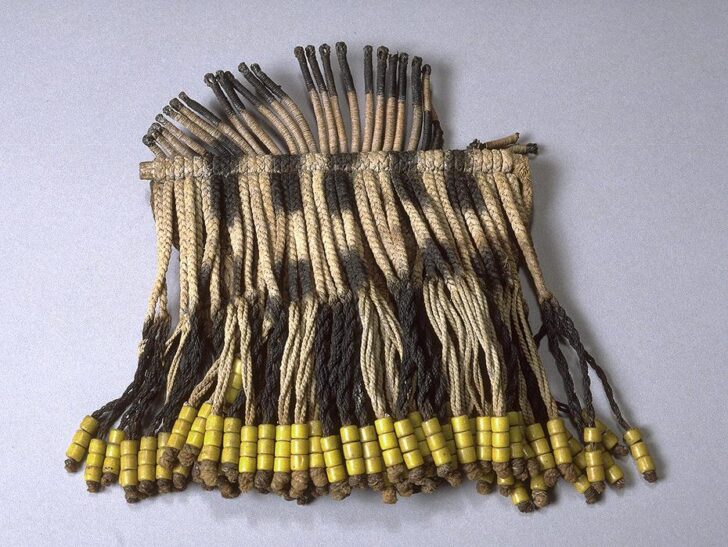Apron
Northern Cameroon; Northeastern Nigeria; Southern Chad

Description
Subject Matter:
This object is listed as made by Kirdi peoples; while most likely correct, it is not without issue. “Kirdi”, meaning pagan, was the label given to the various peoples from northern Cameroon, northeastern Nigeria, and southern Chad by neighboring Fulani and Kanuri peoples because they did not practice Islam, while the latter do. The people collectively known as “Kirdi” are actually many different cultural groups with their own customs. However, due to a lack of information on where exactly this object came from, it is not possible to say with certainty which group of people created it.
Aprons, called pikuran in some areas, were worn by Kirdi girls and women on special and ceremonial occasions. Around the age of six or seven young girls began wearing a leather belt with two straps, sometimes with a second string belt, where four string panels would hang down in front and one in back. At a marriageable age, young women wore beaded aprons to indicate their eligibility for marriage. In addition to aprons, belts of brass rings or beads were also worn, as more objects displayed a woman’s wealth and status. Various designs and styles referred to a woman’s cultural group, marital status, and age. When Cameroon gained independence in 1961, the government issued regulations requiring that women be fully dressed. In some areas, these aprons are still used, but no longer made.
References Cited:
Gebauer, Paul. 1979. Art of Cameroon. Portland, Or.: Portland Art Museum.
Lembezat, Bertrand. 1961. Les populations païennes du Nord-Cameroun et de l'Adamaoua. Paris: Presses Universitaires de France.
Lembezat, Bertrand. 1952. Mukulehe; un clan montagnard du Nord-Cameroun; coutumes, rites, croyances. Paris: Berger-Levrault.
Northern, Tamara. 1984. The Art of Cameroon. Washington, D.C.: Smithsonian Institution.
Page, Donna. 2007. A Cameroon World. New York: QCC Art Gallery Press.
Physical Description:
An apron with columns of woven fiber hanging from a wooden rod that have alternating patches of dark and light coloring. Attached to the bottom is a fiber fringe with alternating light and dark coloring with yellow beads. The top of the apron also has small stiffened fiber rods with alternating patches of light and dark coloring.
Usage Rights:
If you are interested in using an image for a publication, please visit https://umma.umich.edu/request-image/ for more information and to fill out the online Image Rights and Reproductions Request Form.